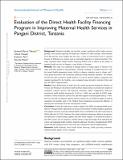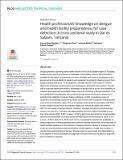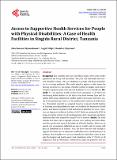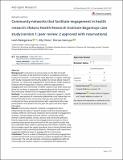| dc.description.abstract | Background: Maternal morbidity and mortality remain significant public health concerns
globally, with Tanzania reporting 398 deaths per 100,000 live births annually. While national
level data provide some insights into the issue, a focus on sub-national levels is required
because of differences in contexts such as rural-urban disparities in maternal mortality. This
study examined Direct Health Facility Financing (DHFF) and its effects on the quality of
maternal health services in Pangani, a rural district in Tanzania.
Methods: This study was conducted in Pangani district of Tanga region in Tanzania. The
study used both qualitative and quantitative methods, including 16 in-depth interviews with
the council health management teams, facility in charges, maternity nurse in charge, and 5
focus group discussions with community health governing committee members. The number
of deliveries that occurred in health facilities, as well as medical supplies, equipment, and
reagents purchased by the facilities, were compared using descriptive statistics before and
after the DHFF implementation.
Results: Direct disbursement of funds from the central government through the Ministry of
Finance and Planning to the primary health facilities reduced delays in procurement, improved
community outreach services, and improved community leaders’ engagements. Deliveries
occurring at health facilities increased by 33.6% (p < 0.001) one year after the HDFF imple mentation. Various medicines, delivery kits, and some reagents increased significantly (p < 0.05).
However, the lack of computers and poor internet connectivity, an insufficient supply of medical
equipment and unstable stock of the Medical Stores Department increased the difficulty of
obtaining the missed items from the selected prime vendor.
Conclusion: Overall, this study shows a positive impact of the DHFF on maternal health service
delivery in Pangani district. Specifically, an increase in the number of medical supplies, equipment,
and reagents necessary to provide maternal health services contributed to the observed increase in
facility deliveries by 33.6%. Moreover, the system minimizes unnecessary delays in the procure ment processes of required drugs, supplies, and other facility reagents. To maximize the impact of
the HDFF system, lack of computers, unstable internet, limited knowledge of the staff about the
system, and inadequate health workforce should be addressed. Therefore, strengthening the DHFF
system and staff training in-service and on the job is essential for smooth implementation.
Keywords: health financing, direct health facility financing, health governing committee,
maternal health, quality of care, Tanzania | en_US |




